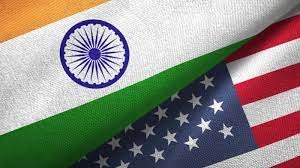
Prepare IAS Coaching
Current Affairs

Title : INDIA US RELATIONS: Present Context
Date : Feb 26, 2022
Description :
Based on a News Article published in the ‘The Hindu’
Useful for UPSC CSE Prelims and Mains (GS Paper II)
Background:
- For their first bilateral encounter in the United States, the Indian Prime Minister met the newly elected US President recently.
- Both leaders talked about a variety of topics, including Covid-19, climate change, and economic cooperation.
- Earlier on his visit to India, US Secretary of State John Kerry stated that the acts of India and the United States will determine the twenty-first century.
The Meet's Highlights Include:
- Discussions focused on strengthening the Indo-US strategic alliance and global topics of mutual importance, such as threats to democracy, Afghanistan, and the Indo-Pacific region.
- One of the primary concerns discussed was Pakistan's position in Afghanistan, and there was a sense that it needed greater "careful monitoring."
- Both sides condemned the use of terrorist proxies and emphasized the significance of denying terrorist organisations logistical, financial, and military support that may be used to plan or carry out terrorist operations.
- They urged the Taliban to follow through on this and all other pledges made under Resolution 2593.
- When India was facing a wave of Covid-19 infections, the US government, companies located in the US, and the Indian diaspora were extremely supportive.
- In the fourth quarter of 2021, India will resume exports of surplus Covid-19 vaccines as part of the Vaccine Maitri initiative and to meet its obligation to the COVAX global pool.
- India brought up a number of problems concerning the Indian community in the United States, including access for Indian professionals and H-1B visas.
Relations between India and the United States:
- About:
- Based on shared democratic values and increasing convergence of interests on bilateral, regional, and global concerns, India-US bilateral relations have evolved into a "global strategic partnership."
- Both countries issued a Declaration of Friendship in Delhi in 2015, as well as a Joint Strategic Vision for Asia-Pacific and the Indian Ocean Region.
- Deal on Civil-Nuclear Cooperation:
- In October 2008, a bilateral civil nuclear cooperation agreement was inked.
- Energy and Climate Change: The US Department of Energy (DOE) and the Government of India have established the Joint Clean Energy Research and Development Center (JCERDC) as a priority initiative under the PACE (Partnership to Advance Clean Energy). The JCERDC is designed to promote clean energy innovations by teams of scientists from India and the US.
- At the Leaders Climate Summit 2021, the India-US Clean Energy Agenda 2030 Partnership was announced.
- Cooperation in Défense:
- With the signing of the 'New Framework for India-US Défense Relations' in 2005, which was then amended for another ten years in 2015, the defence relationship has emerged as a fundamental pillar of the India-US strategic partnership.
- In the previous few years, India and the United States have signed several key defense agreements, as well as formalizing the QUAD four-nation alliance (India, US, Japan and Australia).
- In the Indo-Pacific, the alliance is considered as a significant counter to China.
- The Malabar exercise in November 2020 was a watershed moment in Indo-US strategic relations; it was the first time in 13 years that all four QUAD countries joined together to deliver a strong message to China.
- From Djibouti in Africa to Guam in the Pacific, India now has access to American bases. It also has access to modern communication technology utilized in US military operations.
- The Basic Exchange and Cooperation Agreement for Geospatial Intelligence is one of four core defence agreements between India and the United States (BECA).
- Agreement on the Security of Military Information in General (GSOMIA).
- Memorandum of Understanding on Logistics Exchange (LEMOA).
- Agreement on communication compatibility and security (COMCASA).
- In 2010, the India-US Counter-Terrorism Cooperation Initiative was signed to increase counter-terrorism cooperation, information sharing, and capacity building.
- In November 2019, a tri-services exercise called Tiger Triumph was held.
- Yudh Abhyas (Army); Vajra Prahar (Special Forces); RIMPAC; Red Flag are examples of bilateral and regional exercises.
- Economic Cooperation:
- India's second largest trade partner and a major destination for India's products and services exports is the United States.
- During the 2020-21 year, the United States will overtake Mauritius as the second largest source of foreign direct investment into India.
- The previous US administration revoked India's special trade status (GSP withdrawal) and placed a number of restrictions; India replied by banning 28 US items.
- The current US administration has allowed all of the previous administration's prohibitions to expire.
- Science & Technology:
- ISRO and NASA are collaborating to develop the NASA-ISRO Synthetic Aperture Radar, a collaborative microwave remote sensing satellite for Earth observation (NISAR).
- Indian Diaspora: The Indian diaspora is becoming more visible in many aspects of life in the United States. For example, the current US Vice-President (Kamala Harris) has extensive ties to India.
Next Steps:
- The stage has been prepared for India and the United States to alter their relationship. Afghanistan is still a major source of concern for both India and the United States, and both countries are now focusing on the larger concerns that are arising in the Indo-Pacific as a result of China's development and assertiveness.
- There is a lot of room to grow bilateral trade between the two countries, especially given the rising anti-China attitude in both countries.
